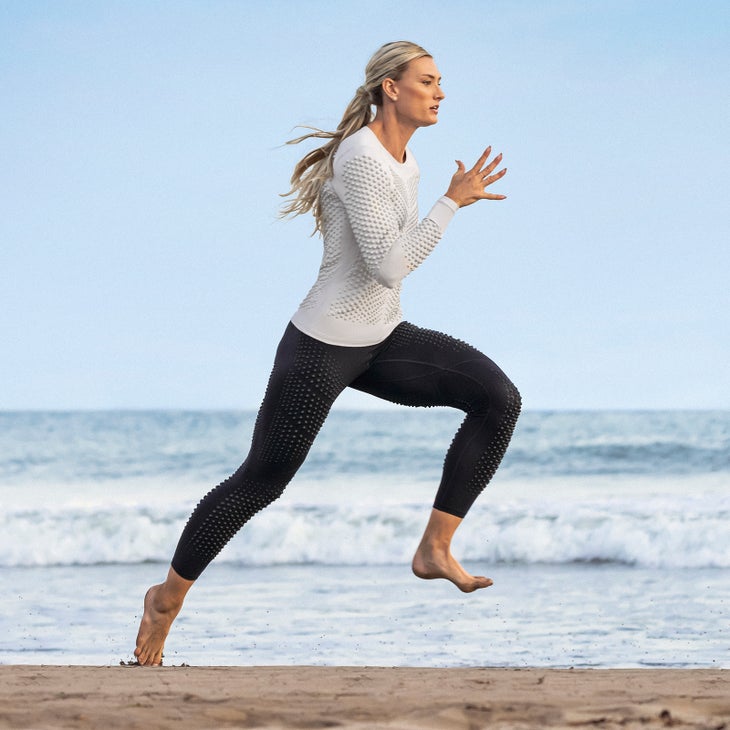Products You May Like
Have you ever put on an outfit and immediately felt and looked stronger? That’s what the Omorpho G-Tights give you—even if you don’t run a step, you get a boost of bionic cool, like you’re a seasoned athlete ready to train.
The running clothes offered from the new company, Omorpho (co-founded by Stefan Olander, previously of Nike), are different from what you’d find in your local big box chain. Each piece is weighted with tiny raised beads throughout the fabric, engineered to make your workout more intense without straining your joints. The training concept they’re utilizing is called micro-loading.
“Sports apparel today is optimized for competition, but most people compete less than 1 percent of the time,” said Olander in a press release. “We’ve created a beautiful and functional collection for the other 99 percent, using a completely new approach to deliver better results by adding small amounts of weight that don’t restrict movement.”
RELATED: Running Shoes Are Finally Being Designed for Women
Before we get into what we thought of the tights, let’s dig deeper into what micro-loading is and how (and if) runner’s should utilize it.
What is Micro-loading?

Micro-loading, as noted in a literature review co-authored by Erin Feser (now chief of science at Omorpho), involves adding resistance of no more than 5 percent of the athlete’s body mass and a minimum of 0.6 percent. In theory, it is enough weight to engage your muscles and create a stimulus, but not enough to overload your joints or slow you down significantly.
The Omorpho line was developed after three years of testing and research to determine the best designs to load the working muscles and minimize the risk of injury.
And overall the research looks good, finding that micro-loading under the right circumstances can build strength to increase power by 8 percent and speed by 3 percent. But specific applications for runners, beyond sprint training, likely need more study.
There are some precautions to keep in mind when adding weight to your training. Coaches and physical therapists we spoke to cautioned that if you don’t have the strength to begin with or are not running with the correct form, weighted clothing can exacerbate your issue and cause injury.
RELATED: Swearing May Help You Run Better—Unless You Do It Too Much
“If someone is overstriding, or they’re running with a certain kind of impairment to their biomechanics, now you’re adding more load for the body to have to try to adapt,” says Natalie Niemczyk, a doctor of physical therapy, running technique specialist, strength and conditioning specialist, and run coach with Revolution Running. “I feel like it could be tricky.”
Instead, Niemczyk recommends runners focus on building muscle through strength training rather than adding weight to their running.
Even Feser recommended to start low and slow when first using the G-Tights. “It’s that tight balance of pushing yourself to train under a new stimulus but not pushing it so much you now need to adjust your training for the following days to accommodate a lot more recovery,” she says.
How We Tested Them and What We Thought
Our testers tried the G-Tights, which are weighted by only about a pound, under a variety of conditions: tempo runs, track workouts, hiking, strength training in the gym, and easy walks. We followed Feser’s advice to dial back the intensity on days we’d be wearing the tights, starting out with easy runs and walks and working our way up over a matter of weeks.
One editor immediately noticed a difference when she first put them on, describing it as “a heavier feeling in the legs, but really evenly spaced out.”
The more you move in them, the extra pound of weight becomes unnoticeable, but you will find yourself fatiguing quicker and maybe some extra soreness the following day. That same editor noticed more soreness in her feet after her regular hike.
Another editor wore them consistently for six weeks during the winter, and feels as fit as ever this spring. She can’t say for sure that it’s due to the gravity sportswear—it could be just one factor in a really good and consistent training season.
On a very positive note, none of our testers had any injuries to report when implementing wearable resistance into their routines, and one tester attributes the tights to making her more cognizant of her form.
It seemed that the best use case was wearing them on strength training days to add a bit more resistance over any kind of running workout.
And though we loved the look, the fabric, and the fit (even the raised weights weren’t uncomfortable to sit and rest in), there’s no getting around the price: $229 for a pair of leggings. But if you want the extra push, it might help to think about them as a piece of workout equipment over something just to wear around the house.
RELATED: Want to Run Faster? You Probably Don’t Need More Speedwork
